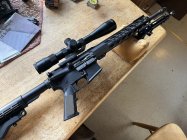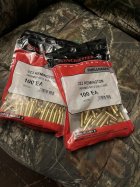Forum Boss
Administrator
I shot ARs for quite a few years. Pros -- I like being able to swap uppers to go from a defense configuration to a longer, heavier barrel for varmint work.
CONS -- the guns are filthy inside. I saw many cycling issues and jams at my club because guys used a lot of wet lube on the bolt carrier and upper which combined with the abundant powder residue coming from the gas port. This created a dirty, filthy mess inside, on the bolt and bolt recesses.
I saw multiple ARs fail because of brass shavings and grit combined with lube/carbon residues getting into the extractor recess and ejector recess. You'd see a thick, black goo with metal shavings and carbon.
My personal experience was that ARs ran best with a good low-drag protective permanent finish on the inside of the upper, plus Teflon-type cream lube on the sliding surfaces of the bolt carrier (and upper contact points) but the rest left relatively dry. Minimal oil on the bolt, other than a proper lube on the bolt lugs.
I did get to shoot an AR variant with a piston instead of the direct gas impingement. Maybe a slight loss of accuracy, but my God, the rifle ran SO much cleaner! It could literally cycle hundreds of rounds without cleaning. The U.S. Military should have adopted a piston-type AR decades ago, IMHO.
As one example, I had to help a local police SWAT team get their ARs to work, because the excess lube and powder residue was causing their rifles to jam or fail to cycle properly.
Even the inventor of the AR15, Eugene Stoner, said his later Stoner 63 design with gas piston was better for military use.

CONS -- the guns are filthy inside. I saw many cycling issues and jams at my club because guys used a lot of wet lube on the bolt carrier and upper which combined with the abundant powder residue coming from the gas port. This created a dirty, filthy mess inside, on the bolt and bolt recesses.
I saw multiple ARs fail because of brass shavings and grit combined with lube/carbon residues getting into the extractor recess and ejector recess. You'd see a thick, black goo with metal shavings and carbon.
My personal experience was that ARs ran best with a good low-drag protective permanent finish on the inside of the upper, plus Teflon-type cream lube on the sliding surfaces of the bolt carrier (and upper contact points) but the rest left relatively dry. Minimal oil on the bolt, other than a proper lube on the bolt lugs.
I did get to shoot an AR variant with a piston instead of the direct gas impingement. Maybe a slight loss of accuracy, but my God, the rifle ran SO much cleaner! It could literally cycle hundreds of rounds without cleaning. The U.S. Military should have adopted a piston-type AR decades ago, IMHO.
As one example, I had to help a local police SWAT team get their ARs to work, because the excess lube and powder residue was causing their rifles to jam or fail to cycle properly.
Even the inventor of the AR15, Eugene Stoner, said his later Stoner 63 design with gas piston was better for military use.

Last edited:













